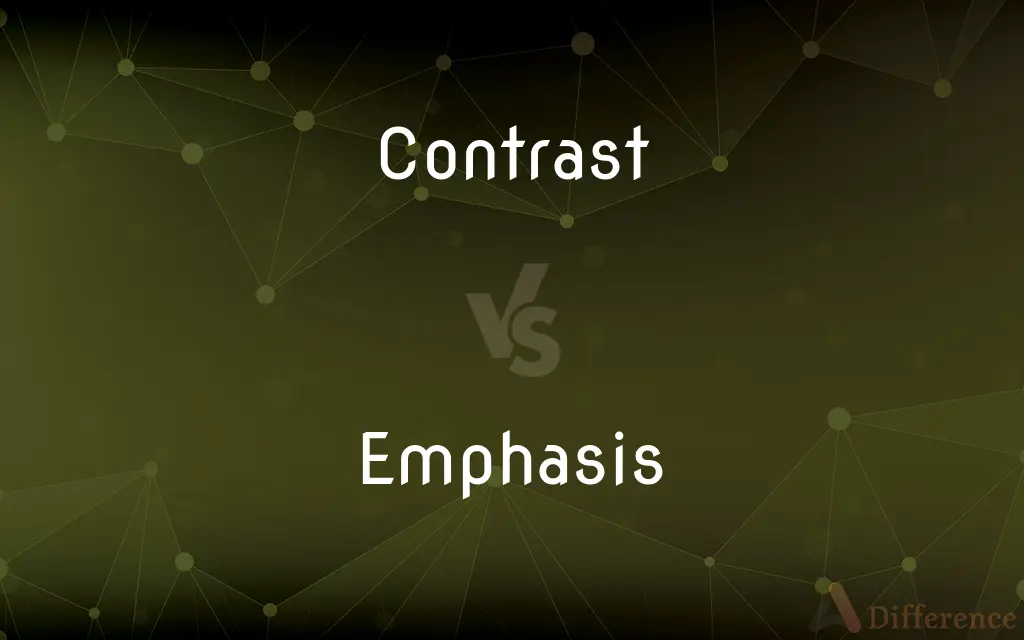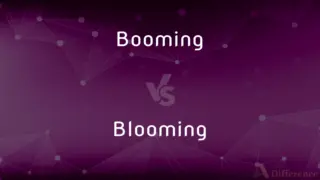Contrast vs. Emphasis — What's the Difference?
By Tayyaba Rehman & Fiza Rafique — Updated on April 8, 2024
Contrast highlights differences between elements, focusing on their distinctiveness, whereas emphasis enhances the importance or prominence of a single element.

Difference Between Contrast and Emphasis
Table of Contents
ADVERTISEMENT
Key Differences
Contrast involves comparing two or more elements to highlight their differences. This technique is used across various fields like art, literature, and photography to bring out the unique characteristics of each element by setting them against each other. Whereas, emphasis focuses on making a particular element stand out by giving it greater importance or prominence. This is achieved through various means such as color, size, or placement, drawing the viewer’s or reader's attention primarily to that point.
In visual arts, contrast can be achieved through the use of opposing colors, light and shadow, or varying textures, creating a dynamic composition that guides the viewer’s eye across the different elements. Emphasis in the same context might be achieved by using a bright color against a muted background, ensuring that a particular aspect of the artwork immediately draws attention.
In writing, contrast is used to juxtapose ideas or characters, thus highlighting their differences and making their unique features more apparent. Emphasis, on the other hand, is used to highlight a key point or theme within the text, often using repetition, font changes, or placement to make certain words or ideas stand out to the reader.
In rhetoric, speakers use contrast to clarify their points by presenting opposing views or highlighting differences between ideas. This technique can make the speaker's argument more compelling by clearly delineating what they support versus what they oppose. Emphasis, however, might be achieved through vocal delivery, such as changing the pitch, volume, or pace, to underline specific words or phrases, making them more memorable to the audience.
In photography, contrast can refer to the difference in tones from the lightest to the darkest, creating visual interest and depth. A photographer might use contrast to lead the viewer's eye to the subject or to create a mood. Emphasis in photography is often achieved through focus, with the subject being in sharp focus while the background is blurred, making the subject the clear point of interest.
ADVERTISEMENT
Comparison Chart
Definition
Highlights differences between two or more elements.
Enhances the importance of a single element.
Purpose
To showcase distinctiveness.
To draw attention or highlight importance.
Techniques
Juxtaposition, opposing colors, light and shadow.
Color, size, placement, repetition.
Field of Use
Art, literature, photography, rhetoric.
Art, literature, photography, speech.
Effect on Audience
Engages by presenting variability.
Focuses attention on key elements.
Compare with Definitions
Contrast
A technique to highlight differences between elements.
The contrast between the protagonist and antagonist underscores the theme of good vs. evil.
Emphasis
Making an element stand out as important.
The emphasis on renewable energy sources is evident in the new policy.
Contrast
In art, a visual tool to distinguish elements.
The artist used contrast in colors to separate the figure from the background.
Emphasis
In art, the technique of drawing attention to a particular part.
The bright red color placed in the center of the painting creates a strong emphasis.
Contrast
In photography, the range between the darkest and lightest tones.
High contrast images often have deep shadows and bright highlights.
Emphasis
In photography, focusing attention on the subject.
The photographer used a shallow depth of field for emphasis on the butterfly.
Contrast
In rhetoric, a method to clarify ideas by presenting them against opposing views.
The politician's speech contrasted his policies with those of his opponent.
Emphasis
In speech, enhancing the importance of words through vocal delivery.
The speaker's emphasis on certain words captivated the audience.
Contrast
In literature, to place ideas or characters side by side for comparison.
The author contrasts the optimism of youth with the wisdom of age.
Emphasis
In writing, to highlight a key point or theme.
Through repetition, the author places emphasis on the concept of freedom.
Contrast
To set in opposition in order to show or emphasize differences
An essay that contrasts city and country life.
Contrasted this computer with inferior models.
Emphasis
Special forcefulness of expression that gives importance to something singled out; stress
A lecture on housekeeping with emphasis on neatness.
Paused for emphasis, then announced the winner's name.
Contrast
To show differences when compared
Siblings who contrast sharply in interests and abilities.
A color that contrasted clearly with the dark background.
Emphasis
Special attention or effort directed toward something
A small-town newspaper's emphasis on local affairs.
Contrast
(Linguistics) To evince a difference that can distinguish meaning
Voiced and voiceless stops contrast in English but not in Cree.
Emphasis
Prominence given to a syllable, word, or words, as by raising the voice or printing in italic type.
Contrast
The act of contrasting; a setting off of dissimilar entities or objects.
Emphasis
Special weight or forcefulness given to something considered important.
He paused for emphasis before saying who had won.
Contrast
The state of being contrasted
Red berries standing in vivid contrast against the snow.
Emphasis
Special attention or prominence given to something.
Anglia TV's emphasis is on Norwich and district.
Put emphasis on the advantages rather than the drawbacks
Contrast
A difference, especially a strong dissimilarity, between entities or objects compared
The contrast between Northern and Southern speech patterns.
Emphasis
Prominence given to a syllable or words, by raising the voice or printing in italic or underlined type.
He used a yellow highlighter to indicate where to give emphasis in his speech.
Contrast
One thing that is strikingly dissimilar to another
My new school was a welcome contrast to the one before.
Emphasis
(phonology) The phonetic or phonological feature that distinguishes emphatic consonants from other consonants.
Contrast
The use of opposing elements, such as colors, forms, or lines, in proximity to produce an intensified effect in a work of art.
Emphasis
(typography) The use of boldface, italics, or other such formatting to highlight text. en
Contrast
The difference in brightness between the light and dark areas of a picture, such as a photograph or video image.
Emphasis
A particular stress of utterance, or force of voice, given in reading and speaking to one or more words whose signification the speaker intends to impress specially upon his audience.
The province of emphasis is so much more important than accent, that the customary seat of the latter is changed, when the claims of emphasis require it.
Contrast
(Linguistics) A difference between units, especially one that distinguishes meaning.
Emphasis
A peculiar impressiveness of expression or weight of thought; vivid representation, enforcing assent; as, to dwell on a subject with great emphasis.
External objects stand before us . . . in all the life and emphasis of extension, figure, and color.
Contrast
(countable) A difference in lightness, brightness and/or hue between two colours that makes them more or less distinguishable.
Emphasis
A special attention given to, or extra importance attached to, something; as, a guided tour of Egypt with emphasis on the monuments along the Nile.
Contrast
(uncountable) The degree of this difference.
The red and the orange don't have much contrast between them — I can hardly tell them apart.
Emphasis
Something to which great importance is attached; as, the need for increased spending on education was the emphasis of his speech.
Contrast
(countable) A control on a television, etc, that adjusts the amount of contrast in the images being displayed.
Emphasis
Special importance or significance;
The red light gave the central figure increased emphasis
The room was decorated in shades of gray with distinctive red accents
Contrast
(countable) A difference between two objects, people or concepts.
Israel is a country of many contrasts.
Emphasis
Intensity or forcefulness of expression;
The vehemence of his denial
His emphasis on civil rights
Contrast
(countable) Something that is opposite of or strikingly different from something else.
Emphasis
Special and significant stress by means of position or repetition e.g.
Contrast
Antithesis.
Emphasis
The relative prominence of a syllable or musical note (especially with regard to stress or pitch);
He put the stress on the wrong syllable
Contrast
(transitive) To set in opposition in order to show the difference or differences between.
Contrast
(intransitive) To form a contrast.
Foreground and background strongly contrast.
Contrast
To stand in opposition; to exhibit difference, unlikeness, or opposition of qualities.
The joints which divide the sandstone contrast finely with the divisional planes which separate the basalt into pillars.
Contrast
To set in opposition, or over against, in order to show the differences between, or the comparative excellences and defects of; to compare by difference or contrariety of qualities; as, to contrast the present with the past.
Contrast
To give greater effect to, as to a figure or other object, by putting it in some relation of opposition to another figure or object.
The figures of the groups must not be all on side . . . but must contrast each other by their several position.
Contrast
The act of contrasting, or the state of being contrasted; comparison by contrariety of qualities.
Place the prospect of the soulIn sober contrast with reality.
Contrast
Opposition or dissimilitude of things or qualities; unlikeness, esp. as shown by juxtaposition or comparison.
The contrasts and resemblances of the seasons.
Contrast
The opposition of varied forms, colors, etc., which by such juxtaposition more vividly express each other's peculiarities.
Contrast
The opposition or dissimilarity of things that are compared;
In contrast to
By contrast
Contrast
The act of distinguishing by comparing differences
Contrast
A conceptual separation or demarcation;
There is a narrow line between sanity and insanity
Contrast
The perceptual effect of the juxtaposition of very different colors
Contrast
The range of optical density and tone on a photographic negative or print (or the extent to which adjacent areas on a television screen differ in brightness)
Contrast
Put in opposition to show or emphasize differences;
The middle school teacher contrasted her best student's work with that of her weakest student
Contrast
To show differences when compared; be different;
The students contrast considerably in their artistic abilities
Common Curiosities
What is the main difference between contrast and emphasis?
Contrast involves highlighting differences, while emphasis focuses on importance.
How do contrast and emphasis function in literature?
Contrast in literature is used to juxtapose ideas or characters, while emphasis highlights key themes or points.
How does contrast enhance rhetorical arguments?
It clarifies points by presenting opposing views, making the speaker’s position more compelling.
Can contrast and emphasis be used together?
Yes, they often work together, especially in visual arts, where contrast can create emphasis.
In what ways can contrast be achieved in visual arts?
Through opposing colors, light and shadow, and varying textures.
Why is contrast important in photography?
Contrast adds depth and interest, guiding the viewer’s eye to the subject.
How does emphasis change the viewer's or reader's focus?
Emphasis draws the viewer’s or reader’s attention to the most important element, making it stand out.
What are some common techniques for creating emphasis in art?
Techniques include using bright colors, large sizes, and strategic placement.
What is the psychological effect of using contrast in design?
Contrast can make designs more engaging and help in retaining the viewer’s interest by highlighting differences.
How can emphasis be used in education?
Emphasis can be used to highlight key concepts or information, aiding in retention and understanding.
Can emphasis be subtle or does it have to be obvious?
Emphasis can be both subtle and obvious, depending on the technique used.
Is contrast more effective in black and white photography?
Contrast can be very effective in both black and white and color photography, but it often stands out more in black and white.
What role does emphasis play in speech?
It makes certain words or phrases more memorable through vocal delivery.
How does emphasis affect the structure of a written work?
It can dictate the structure by highlighting the most important points or themes for the reader.
Can emphasis be achieved through layout in graphic design?
Yes, emphasis can be achieved through the layout by manipulating the visual hierarchy.
Share Your Discovery

Previous Comparison
Starfish vs. Jellyfish
Next Comparison
Booming vs. BloomingAuthor Spotlight
Written by
Tayyaba RehmanTayyaba Rehman is a distinguished writer, currently serving as a primary contributor to askdifference.com. As a researcher in semantics and etymology, Tayyaba's passion for the complexity of languages and their distinctions has found a perfect home on the platform. Tayyaba delves into the intricacies of language, distinguishing between commonly confused words and phrases, thereby providing clarity for readers worldwide.
Co-written by
Fiza RafiqueFiza Rafique is a skilled content writer at AskDifference.com, where she meticulously refines and enhances written pieces. Drawing from her vast editorial expertise, Fiza ensures clarity, accuracy, and precision in every article. Passionate about language, she continually seeks to elevate the quality of content for readers worldwide.














































